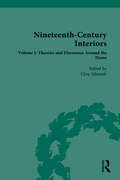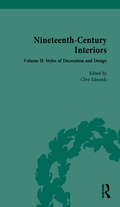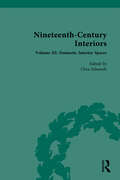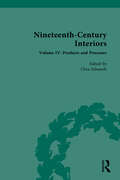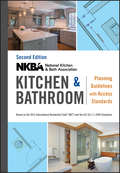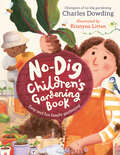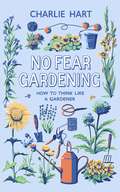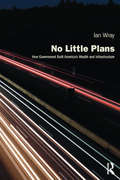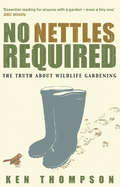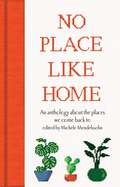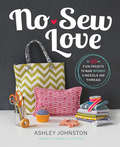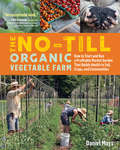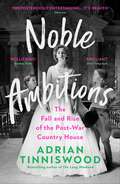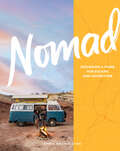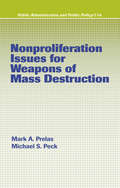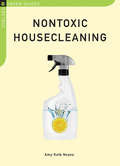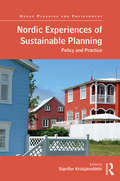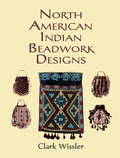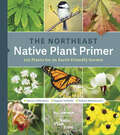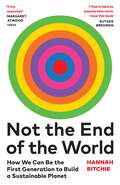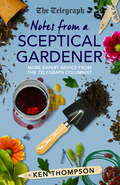- Table View
- List View
Nineteenth-Century Interiors: Volume I: Theories and Discourses Around the Home
by Clive EdwardsThis volume of primary source materials documents the nature of the home and the theories and discussions around the concept. It examines the class divisions that become evident with the ostentatious lifestyles of political and society hostesses at the peak, whilst middle-class housing often in suburbia, seemed to have created a separation of home and work, arguably suggesting men and women lived in separate spheres. Working-class interiors, often seen the eyes of middle-class observers, were at the bottom of the hierarchy and often reflected concerns of social inequality and misery. The documents also address the process of purchasing and decorating a home, advice on decoration and home management, the nature of taste and comfort, and the symbolic roles of the home as an anchor in society. Accompanied by extensive editorial commentary, this collection will be of great interest to students and scholars of art history.
Nineteenth-Century Interiors: Volume I: Theories and Discourses Around the Home
This volume of primary source materials documents the nature of the home and the theories and discussions around the concept. It examines the class divisions that become evident with the ostentatious lifestyles of political and society hostesses at the peak, whilst middle-class housing often in suburbia, seemed to have created a separation of home and work, arguably suggesting men and women lived in separate spheres. Working-class interiors, often seen the eyes of middle-class observers, were at the bottom of the hierarchy and often reflected concerns of social inequality and misery. The documents also address the process of purchasing and decorating a home, advice on decoration and home management, the nature of taste and comfort, and the symbolic roles of the home as an anchor in society. Accompanied by extensive editorial commentary, this collection will be of great interest to students and scholars of art history.
Nineteenth-Century Interiors: Volume II: Styles of Decoration and Design
This volume of primary source materials documents the nineteenth-century search for a representative style, and the alternating fashions for interiors that demonstrated the consumerism of the period. Although in some senses every interior is unique so that a style canon may seem to be meaningless, there have been important historical trends or styles that have influenced individual interiors, and these have formed the groundwork from which other styles and tastes have developed and changed. Accompanied by extensive editorial commentary, this collection will be of great interest to students and scholars of art history.
Nineteenth-Century Interiors: Volume III: Domestic Interior Spaces
This volume of primary source materials documents the spatial layouts of the nineteenth century home as they often became more precisely planned with rooms for specific purposes being developed. The styles began to truly reflect the owner’s taste and position. The range is of course vast from single room dwellings to large-scale mansions and numerous variations in-between. Accompanied by extensive editorial commentary, this collection will be of great interest to students and scholars of art history.
Nineteenth-Century Interiors: Volume IV: Products and Processes
This volume of primary source materials documents the essential practical aspects of making a home, decorating it and then furnishing it. The crucial constitutive parts that make up an interior from floor to ceiling are considered here in detail. The role of advice books and articles that attempted to direct homemakers in particular directions are examined, as are the more practical how-to publications that demonstrated the processes of interior decoration. Accompanied by extensive editorial commentary, this collection will be of great interest to students and scholars of art history.
NKBA Kitchen and Bathroom Planning Guidelines with Access Standards
by NKBA (National Kitchen and Bath Association)The essential kitchen and bath design reference, updated with the latest codes NKBA Kitchen & Bathroom Planning Guidelines with Access Standards is the industry standard reference, written by the National Kitchen and Bath Association and updated with the latest codes and standards. This new second edition features revised guidelines for cooking surface clearance, electrical receptacles, and ventilation for kitchens, as well as ceiling height, shower size, electrical receptacles, and ventilation for bathrooms. Revised to reflect the 2015 International Residential Code and the ICC A117.1-2009, all illustrations have been expertly redrawn using 2020 Design and Chief Architect Software to provide clearer visual reference for real-world application. With thirty-one kitchen guidelines and twenty-seven bathroom guidelines, this book provides full planning recommendations, code references, and access standards for today's kitchen and bath design professional. Kitchens and bathrooms are the two most functional rooms in the house, and also the most code-intensive. It is imperative that design professionals stay up to speed on the latest guidelines to ensure the safety and efficiency of their projects. Get up to date on the latest kitchen and bath codes Reference a new range of standards for clearance, ventilation, and more Design for storage based on the results of university research Examine illustrative and descriptive plans, sections, and perspective views The NKBA guidelines are based on a composite of historical review, current industry environment and practices, emerging trends, consumer lifestyles, research, and building codes. These factors combine to help kitchen and bath professionals create designs that are beautiful, functional, accessible, and safe. The NKBA Kitchen & Bathroom Planning Guidelines with Access Standards is the complete reference professionals turn to for the latest in kitchen and bath design.
NKBA Kitchen and Bathroom Planning Guidelines with Access Standards
by NKBA (National Kitchen and Bath Association)The essential kitchen and bath design reference, updated with the latest codes NKBA Kitchen & Bathroom Planning Guidelines with Access Standards is the industry standard reference, written by the National Kitchen and Bath Association and updated with the latest codes and standards. This new second edition features revised guidelines for cooking surface clearance, electrical receptacles, and ventilation for kitchens, as well as ceiling height, shower size, electrical receptacles, and ventilation for bathrooms. Revised to reflect the 2015 International Residential Code and the ICC A117.1-2009, all illustrations have been expertly redrawn using 2020 Design and Chief Architect Software to provide clearer visual reference for real-world application. With thirty-one kitchen guidelines and twenty-seven bathroom guidelines, this book provides full planning recommendations, code references, and access standards for today's kitchen and bath design professional. Kitchens and bathrooms are the two most functional rooms in the house, and also the most code-intensive. It is imperative that design professionals stay up to speed on the latest guidelines to ensure the safety and efficiency of their projects. Get up to date on the latest kitchen and bath codes Reference a new range of standards for clearance, ventilation, and more Design for storage based on the results of university research Examine illustrative and descriptive plans, sections, and perspective views The NKBA guidelines are based on a composite of historical review, current industry environment and practices, emerging trends, consumer lifestyles, research, and building codes. These factors combine to help kitchen and bath professionals create designs that are beautiful, functional, accessible, and safe. The NKBA Kitchen & Bathroom Planning Guidelines with Access Standards is the complete reference professionals turn to for the latest in kitchen and bath design.
The No-Dig Children's Gardening Book: Easy and Fun Family Gardening
by Charles DowdingDon't like endless digging and weeding? Don't let that stop you from getting into gardening! The simple and achievable gardening projects in this book are perfect for parents and young children to do together. All are based on Charles Dowding's trademark no-dig technique, which perfectly lends itself to gardening with little ones who can't manage heavy digging and who will quickly grow bored of endless weeding.Projects are broken down into easy, step-by-step processes, designed to be carried out by children. Attractive, full-bleed photography is supplemented with fun illustration and fully illustrated factual spreads. Running throughout the gardening projects are extra little facts about plants and wildlife, as well as things to look out for when you are outdoors.
No Fear Gardening: How To Think Like a Gardener
by Charlie HartAre you frightened of your garden? Terrified of accidentally bringing death to a sap-filled friend? Put off by the overwhelming number of species of plants and their baffling Latin names? Whether your garden is a sprawling country plot or a kitchen windowsill, gardening is good for the mind, body and soul. Yet just the thought of picking up a pair of secateurs can strike fear into even the bravest of hearts, meaning we often don't make the most of our personal Edens.Charlie's 'no fear' approach to gardening will help you find the easy path to beautiful borders and jampacked vegetable beds. A reassuring, simple-to-use handbook, No Fear Gardening is aimed at all budding gardeners and anyone who might be missing out simply because they don't know how and where to start. Whatever the reason, this book will answer all your questions. From digestible lists of what seeds to plant where, guides to pruning and how to cope with difficult spots to Charlie's favourite vegetables to grow (and, more importantly, eat) and essential pieces of kit, Charlie has condensed a wealth of gardening know-how into easy-to-follow and practical tips. With its unique, liberating approach, No Fear Gardening will inspire you to dust the cobwebs off your watering can and get your garden blooming, whatever the weather or season.
No Little Plans: How Government Built America’s Wealth and Infrastructure (Planning, History and Environment Series)
by Ian WrayIs planning for America anathema to the pursuit of life, liberty and happiness? Is it true, as ideologues like Friedrich Von Hayek, Milton Friedman, and Ayn Rand have claimed, that planning leads to dictatorship, that the state is wholly destructive, and that prosperity is owed entirely to the workings of a free market? To answer these questions Ian Wray’s book goes in search of an America shaped by government, plans and bureaucrats, not by businesses, bankers and shareholders. He demonstrates that government plans did not damage American wealth. On the contrary, they built it, and in the most profound ways. In three parts, the book is an intellectual roller coaster. Part I takes the reader downhill, examining the rise and fall of rational planning, and looks at the converging bands of planning critics, led on the right by the Chicago School of Economics, on the left by the rise of conservation and the ‘counterculture’, and two brilliantly iconoclastic writers – Jane Jacobs and Rachel Carson. In Part II, eight case studies take us from the trans-continental railroads through the national parks, the Federal dams and hydropower schemes, the wartime arsenal of democracy, to the postwar interstate highways, planning for New York, the moon shot and the creation of the internet. These are stories of immense government achievement. Part III looks at what might lie ahead, reflecting on a huge irony: the ideology which underpins the economic and political rise of Asia (by which America now feels so threatened) echoes the pragmatic plans and actions which once secured America’s rise to globalism.
No Little Plans: How Government Built America’s Wealth and Infrastructure (Planning, History and Environment Series)
by Ian WrayIs planning for America anathema to the pursuit of life, liberty and happiness? Is it true, as ideologues like Friedrich Von Hayek, Milton Friedman, and Ayn Rand have claimed, that planning leads to dictatorship, that the state is wholly destructive, and that prosperity is owed entirely to the workings of a free market? To answer these questions Ian Wray’s book goes in search of an America shaped by government, plans and bureaucrats, not by businesses, bankers and shareholders. He demonstrates that government plans did not damage American wealth. On the contrary, they built it, and in the most profound ways. In three parts, the book is an intellectual roller coaster. Part I takes the reader downhill, examining the rise and fall of rational planning, and looks at the converging bands of planning critics, led on the right by the Chicago School of Economics, on the left by the rise of conservation and the ‘counterculture’, and two brilliantly iconoclastic writers – Jane Jacobs and Rachel Carson. In Part II, eight case studies take us from the trans-continental railroads through the national parks, the Federal dams and hydropower schemes, the wartime arsenal of democracy, to the postwar interstate highways, planning for New York, the moon shot and the creation of the internet. These are stories of immense government achievement. Part III looks at what might lie ahead, reflecting on a huge irony: the ideology which underpins the economic and political rise of Asia (by which America now feels so threatened) echoes the pragmatic plans and actions which once secured America’s rise to globalism.
No Nettles Required: The Reassuring Truth About Wildlife Gardening
by Ken ThompsonIn 2003 a MORI poll for the Royal Horticultural Society revealed that an extraordinary number of us are interested in attracting wildlife into our gardens. It also indicated, however, that many of us have no idea how to go about it. Information is sparse, and public opinion seems to suggest that gardens that are plentiful in wildlife are unattractive, expensive to upkeep and hard work to maintain. But this couldn't be further from the truth.In this illuminating book, Ken Thompson explains that encouraging wildlife is actually entirely compatible with ordinary gardening, costs next to nothing and is almost completely effortless. Packed with helpful hints and tips, the book shows us how easy it is to fill our gardens with everything from foxes, frogs and mice to butterflies, ladybirds and literally thousands of fascinating creepy-crawlies. Why should we? Because we'll be promoting the biodiversity of the UK, we'll be reconnecting with nature, getting more from our gardens, and we'll be doing our plants a favour.
No Place Like Home: An anthology about the places we come back to (Macmillan Collector's Library #338)
by Michèle MendelssohnWhat makes a home, and when do we really feel at home? Is it a physical place, or something we all carry inside us wherever we go?Part of the Macmillan Collector’s Library; a series of stunning, pocket-sized classics with ribbon markers. These beautiful books make perfect gifts or a treat for any book lover. This edition is edited and introduced by writer and academic Professor Michèle Mendelssohn.In No Place Like Home: An anthology about the places we come back to, writers from around the world celebrate the comfort of home, capturing its emotional power and sharing nostalgia for what we leave behind. There are extracts from the likes of Louisa May Alcott, Kenneth Graham and Charlotte Brontë as well as lesser known but no less insightful poets and writers to discover.
No-Sew Love: Fifty Fun Projects to Make Without a Needle and Thread
by Ashley JohnstonAlthough Ashley Johnston is comfortable with a needle and thread-and really enjoys making handmade items for her children and home-she could certainly understand that sewing machines can strike fear and dread into the hearts of many crafters. The complicated machinery with the fussy parts as well as confusing pattern directions send many people running from any craft that requires sewing. No-Sew Love is filled with ideas for the non-sewing crafter or for the more casual sewist who would rather not haul out the sewing machine for a quick project. Materials all easily found at craft and fabric stores-hem tape, fusible webbing, a variety of glues, and of course, fabric-are all you need to whip up the 50 no-sew wonders in the book. There are throw pillows, grommet curtain panels, cute kids' clothing, holiday decorations, and even accessories for you! Projects are photographed at each step for crystal-clear directions, and sure-to-please results.
The No-Till Organic Vegetable Farm: How to Start and Run a Profitable Market Garden That Builds Health in Soil, Crops, and Communities
by Daniel MaysNo-till — a method of growing crops and providing pasture without disturbing the soil — has become an important alternative to standard farming practices. In this comprehensive guide to successful no-till vegetable farming for aspiring and beginning farmers, author Daniel Mays, owner and manager of an organic no-till farm in Maine, outlines the environmental, social, and economic benefits of this system. The methods described are designed for implementation at the human scale, relying primarily on human power, with minimal use of machinery. The book presents streamlined planning and record-keeping tools as well as marketing strategies, and outlines community engagement programs like CSA, food justice initiatives, and on-farm education.
Noble Ambitions: The Fall and Rise of the Post-War Country House
by Adrian TinniswoodFrom the bestselling author of The Long Weekend: a wild, sad and sometimes hilarious tour of the English country house after the Second World War, when Swinging London collided with aristocratic values.'Preposterously entertaining' Observer'Brilliant' Daily Telegraph'Rollicking' Sunday TimesAs the sun set slowly on the British Empire in the years after the Second World War, the nation's stately homes were in crisis. Tottering under the weight of rising taxes and a growing sense that they had no place in twentieth-century Britain, hundreds of ancestral piles were dismantled and demolished.Yet - perhaps surprisingly - many of these great houses survived, as dukes and duchesses clung desperately to their ancestral seats and tenants' balls gave way to rock concerts, safari parks and day trippers. From the Rolling Stones rocking Longleat to Christine Keeler rocking Cliveden, Noble Ambitions takes us on a lively tour of these crumbling halls of power.* A Daily Telegraph Book of the Year ** Longlisted for the William MB Berger Prize for British Art History *
Nomad: Designing a Home for Escape and Adventure
by Emma ReddingtonA lush, photographic guide to unconventional homes around the world and the free spirits who live and work in them.
Nonproliferation Issues For Weapons of Mass Destruction
by Mark A. Prelas Michael PeckNonproliferation Issues for Weapons of Mass Destruction provides an understanding of WMD proliferation risks by bridging complex technical and political issues. The text begins by defining the world conditions that foster proliferation, followed by an analysis of characteristics of various classes of WMDs, including nuclear, biological, and chemica
Nontoxic Housecleaning (Chelsea Green Guides)
by Amy Kolb NoyesWhen it comes to cleaning products, society often values convenience over personal and planetary health, thanks to decades of advertising propaganda from the chemical companies that market overpriced and dangerous concoctions. But awareness is changing: Not only are homemade and nontoxic cleaners strong enough for the toughest grunge, they are often as convenient as their commercial counterparts. Nontoxic Housecleaning—the latest in the Chelsea Green Guide series—provides a way for people to improve their immediate environment every day. Pregnant women, parents of young children, pet owners, people with health concerns, and those who simply care about a healthy environment—and a sensible budget—can all benefit from the recipes and tips in this guide. Included are tips for: The basic ingredients: what they are, and why they work. Specific techniques for each room and cleaning need in the house. Detailed recipes for homemade cleaners, including floor polishes, all-purpose cleanser, disinfecting cleanser, window cleaner, oven cleaner, furniture polish, mold- and mildew-killing cleansers, bathroom scrub, deodorizers, stain removers, laundry boosters and starch, metal polishes, scouring powder, and more.
Nordic Experiences of Sustainable Planning: Policy and Practice (Urban Planning and Environment)
by Sigríður KristjánsdóttirFor well over a decade, there has been a drive towards sustainability in planning throughout the Nordic countries. But are these countries experiencing a paradigm shift in planning research and practice with regards to sustainability? Or is the sustainability discourse leading them into an impasse in planning? This book includes overviews of the planning systems in the five Nordic countries, drawing attention to their increasing focus on sustainability. A leading team of scholars from the fields of planning, urban design, architecture, landscape, economics, real estate and tourism explore how the notion of sustainability has shaped planning research in the Nordic countries. Case studies from Iceland, Sweden, Finland, Norway and Denmark shed light on what lessons can be learned and some possible future developments. By focusing on the actual settings and practices of local and regional planning activities, it enables a discussion on the current state of planning for a more sustainable future. This book will be valuable reading for students and academics interested in planning policy, environmental policy, architecture and urban design work.
Nordic Experiences of Sustainable Planning: Policy and Practice (Urban Planning and Environment)
by Sigríður KristjánsdóttirFor well over a decade, there has been a drive towards sustainability in planning throughout the Nordic countries. But are these countries experiencing a paradigm shift in planning research and practice with regards to sustainability? Or is the sustainability discourse leading them into an impasse in planning? This book includes overviews of the planning systems in the five Nordic countries, drawing attention to their increasing focus on sustainability. A leading team of scholars from the fields of planning, urban design, architecture, landscape, economics, real estate and tourism explore how the notion of sustainability has shaped planning research in the Nordic countries. Case studies from Iceland, Sweden, Finland, Norway and Denmark shed light on what lessons can be learned and some possible future developments. By focusing on the actual settings and practices of local and regional planning activities, it enables a discussion on the current state of planning for a more sustainable future. This book will be valuable reading for students and academics interested in planning policy, environmental policy, architecture and urban design work.
North American Indian Beadwork Designs
by Clark WisslerThis concise volume documents a fascinating and unique art form -- Native American beadwork. Including examples of handiwork from Eastern woodlands and Plains Indians, the author offers a clear, illuminating discussion of the origins, execution, and symbolism of Indian beadwork used to ornament belts, garters, pouches, and much more. Over 300 figures.
The Northeast Native Plant Primer: 235 Plants for an Earth-Friendly Garden
by Uli Lorimer Native Plant TrustBring your garden to life—and life to your garden Do you want a garden that makes a real difference? Choose plants native to our Northeast region. The rewards will benefit you, your yard, and the environment—from reducing maintenance tasks to attracting earth-friendly pollinators such as native birds, butterflies, and bees. Native plant expert Uli Lorimer of the Native Plant Trust makes adding these superstar plants easier than ever before, with proven advice that every home gardener can follow. This incomparable sourcebook includes 235 recommended native trees, shrubs, vines, ferns, wildflowers, grasses, sedges, and annuals. It&’s everything you need to know to create a beautiful and beneficial garden. This must-have handbook is for gardeners in Connecticut, Delaware, Maine, Massachusetts, New Hampshire, New Jersey, New York, eastern Ohio, Pennsylvania, Rhode Island, and Vermont.
Not the End of the World: How We Can Be the First Generation to Build a Sustainable Planet
by Hannah Ritchie‘A book for anyone who finds it difficult to believe in a better future’ THE TIMESFeeling anxious, powerless, or confused about the future of our planet? This book will transform how you see our biggest environmental problems -- and how we can solve them.A STYLIST BEST NON-FICTION 2024 * A GUARDIAN BIGGEST FICTION AND NON-FICTION FOR 2024 * A WATERSTONES ‘BOOK YOU NEED TO READ IN 2024’ * A GUARDIAN ‘FIVE GREAT READS’ We are bombarded by doomsday headlines that tell us the soil won't be able to support crops, fish will vanish from our oceans, that we should reconsider having children.But in this bold, radically hopeful book, data scientist Hannah Ritchie argues that if we zoom out, a very different picture emerges. The data shows we've made so much progress on these problems, and so fast, that we could be on track to achieve true sustainability for the first time in history.Packed with the latest research, practical guidance and enlightening graphics, this book will make you rethink almost everything you've been told about the environment, from the virtues of eating locally and living in the countryside, to the evils of overpopulation, plastic straws and palm oil. It will give you the tools to understand what works, what doesn't and what we urgently need to focus on so we can leave a sustainable planet for future generations.These problems are big. But they are solvable. We are not doomed. We can build a better future for everyone. Let's turn that opportunity into reality.‘I find it hard to express how much I love this book’ RUTGER BREGMAN * 'An unmissable myth-busting book to save our planet – read it' TIM SPECTOR
Notes From a Sceptical Gardener: More expert advice from the Telegraph columnist
by Ken ThompsonWhat is the best way to kill weeds in paving? How scared should we really be of Japanese knotweed? And what is a weed anyway? Biologist Ken Thompson set out to write a different kind of gardening column, one that tackles what he calls ‘the grit in the gardening oyster’. In this new collection he takes a look at some of the questions faced by gardeners everywhere in a bid to sort the truth from the wishful thinking. Why are the beaks of British great tits getting longer? Which common garden insect owns a set of metal-tipped running spikes? Why might growing orange petunias land you in hot water? Are foxes getting bigger? How do you stop the needles falling off your Christmas tree? This expert’s miscellany of (mostly) scientifically-tested garden lore will make you look at your garden through fresh eyes.
